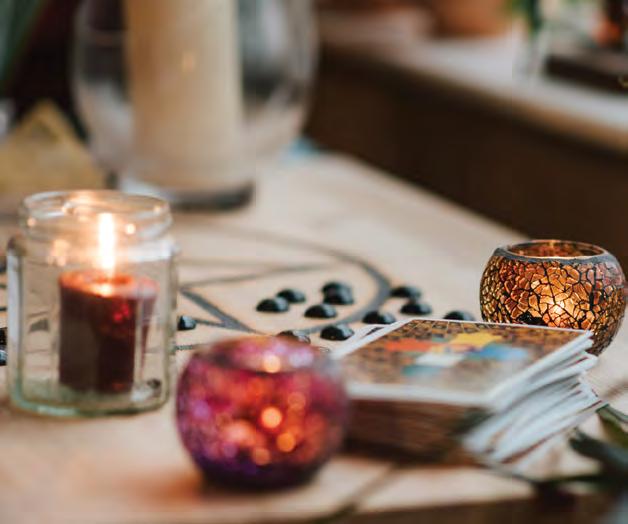
4 minute read
HOW TO MAKE A VISION BOARD: Creating Structure and Setting Intentions
By Emily Alvarez, MPS, ATR-BC
For the past several years, I have been making a yearly vision board. It started as a way to create structure and set intentions during a major transition in my life several years ago. I was beginning my career as an art therapist, recently had a baby, and was planning to move overseas. My vision board flew with me and my family to Trinidad and Tobago, where I built a new community, established my professional work, and grew as an individual.
Now, as each New Year and season of life rolls around, I look forward to gathering words and images to help me formulate and attain new goals and visions for the year ahead. A vision board can be used at any time in your life when you are making plans for a major project, life goal, or shift in an area of your life. The New Year is a great time to create a vision board, as it physically marks the beginning of a new season and translates a
New Year’s resolution into visual form. A vision board can help to solidify a plan, goal, or dream, as well as create structure and guidance in how to achieve it. When you see your goals in front of you, it is a constant reminder of where you are headed and what you want from your life. It can inspire you, motivate you, and help keep you on track.
If you need community support to help you get and stay motivated, I recommend attending a vision board workshop, or perhaps hosting a gathering with a few friends. I was able to host a women’s group in January in which we made vision boards. We started the group with a guided meditation to help us get clear on goals and desires for the year. Then, we journaled to process our thoughts on paper before creating our vision boards. The gathering can also be a social event, where you share goals with others and gain support in achieving them.
You may find that working alone is more comfortable if you prefer to focus on your own. Depending on how much structure and planning you need, you may want to spend some time journaling or writing down any visions or goals you have to help you get started. Quiet meditation may help you visualize your goals and open up to what is possible. Through meditation, you may receive intuitive guidance through an image or vision, sensations in your body, a word or phrase, or an inner knowing or feeling. Do not try to block anything that comes up for you, just acknowledge it. You may write down anything that is useful in formulating your vision, or pocket it for another time.
When you are ready to start your vision board, set aside time to focus fully on creating it. Arrange your materials in a clear, quiet space that is free from distractions. You may have the items for your board already chosen, or you can take the time to glean your content as you go. You may gather words, phrases, or images that speak to you and align with your vision, whether from magazine clippings, personal photos, or stock images found on the internet. You may choose content based on the clear intentions you already made previously from journaling or meditation. You can also work without a clear vision or goal in mind, and simply pull words and images that resonate with you. Working in this way allows your intuition to guide you. Your vision may become clearer as you are able to see and reflect upon your chosen items, which may indicate what is truly important to you. Some things to consider as your vision board comes to

by Mary Mannix
life include: What stands out the most? What kind of color scheme did you use? Do you recognize any themes? Is your content mostly focused on Self? Relationships? Career? Spirituality? What you choose and how you arrange your images are all significant.
Use a piece of cardstock or poster board that fits all your chosen items. You may want to cut the board into a specific shape like a heart or a circle. Then, begin to arrange your collage items on the board as you see fit. There is no right or wrong way to arrange your vision board. Some ideas include placing what is most important or central to you in the center and working outward in a circular pattern. Or the board can read chronologically from left to right to depict the steps and stages of your goal. Another board may be separated into sections to highlight various areas of your life such as relationships, work, health, and family. You are the designer of your own vision, so do what feels right for you.
After you have laid out and arranged all the pieces you want to include, begin to glue everything on the board with glue stick or Elmer’s glue. Feel free to add other mixed media such as paint, pastels, paper, or marker to the board.
When it is complete, I recommend hanging it in a prominent place where you will see it often, such as over your desk, near an altar, or in your bedroom. From time to time, you may return to your journal and your original goals and reflect upon how things have progressed or changed. Perhaps you have achieved a goal and are ready to move on to the next step. Maybe you decide to move in a different direction than originally intended. Or maybe you have a new vision all together that you want to add to your board. The vision board is a living art piece, where you may change and add items as your life ebbs and flows with the seasons. ❁

Editor’s Note: This article was originally published in our Spring 2018 Issue 6




